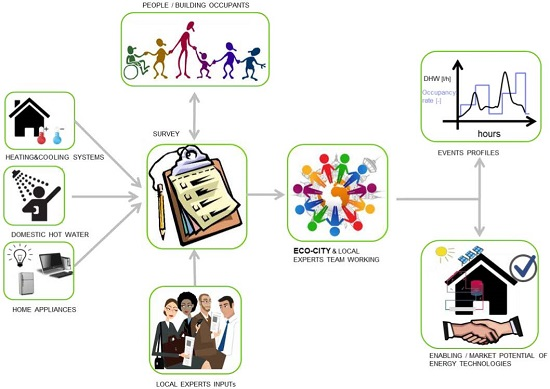Methodologies Developed for EcoCity Related Projects: New Borg El Arab, an Egyptian Case Study
Abstract
:1. Introduction
VTT EcoCity Concept
- Type of development: II—expansion of urban area
- Development phase: 1—pilot/planning phase
- Key implementation mode: b (integrated sustainability plan) and c (civic engagement)
2. Methodologies Developed for EcoCity Related Projects
2.1. Ecocity Roadmap
- (1)
- setting key priorities (vision),
- (2)
- developing thematic roadmaps and
- (3)
- identifying implementation actions.
2.1.1. Workshop 1: EcoCity Vision
- Task sheets were filled by the team members prior to the workshop event.
- A workshop for the EcoCity roadmap was held using the roadmapping method described by [21].
- Applicable results from the EcoCity feasibility study workshop were also included in this vision for the EcoCity roadmap.
- What do I like of our situation today?
- What do I not like of our situation today?
- What do I want in the future?
- What do I not want in the future?
2.1.2. Workshop 2: EcoCity Roadmap Outline
- Task sheets were filled by the team members prior to the workshop event.
- A workshop for the EcoCity roadmap was held using the roadmapping method described by [21].
- Applicable results from the EcoCity feasibility study workshop were also included in this vision for the EcoCity roadmap.
- (1)
- Identify key business drivers for change and
- (2)
- Define key actions and enablers needed for the vision to be achieved.
2.1.3. Workshop 3: Implementation Actions
- Task sheets were filled by the team members prior to the workshop event.
- A workshop for the EcoCity roadmap was held using the roadmapping method described by [21].
- (1)
- Development of Implementation Actions (IA) as individual work,
- (2)
- Commenting and further development of IAs as group work,
- (3)
- Implementation plan for IAs as group work, meaning placing them on a timeline and
- (4)
- Presentation, commenting and finalizing the results, all together.
2.1.4. EcoCity Feasibility Study
- Business As Usual (BAU)
- Energy consumption (kWh/year) energy source
- Water consumption (m3/year)
- Material consumption (kg/year)
- Emissions (kg CO2 equivalent/year)
- Wastewater (m3/year)
- Solid waste (tonnes/year) hazardous/non hazardous
- Low Investment Sustainability (LIS) scenario
- High Investment Sustainability (HIS) scenario
2.2. Residents Energy Survey and Building Consumption Assessment
3. Results Concerning the Egyptian Case
3.1. Roadmap
3.2. Feasibility Study
3.2.1. Residential Sector
3.2.2. Transport Sector
- Forecasted population based on the proposed Master Plan and increase rate of population.
- Little change in the modal split to the benefit of the bus mode.
- Change in the road infrastructures based on the Master Plan.
4. Discussion and Conclusions
- How many plants are there in the city? What is the expected growth of that number?
- How many employees are there? What is the expected growth of that number?
- How developed is the technology used?
- How skilled are the employees? What are the required skills?
- What kinds of energy sources are used? What is the distribution of these?
- Water supply and water treatment.
- Adequate methodologies are needed to support EcoCity development in response to the challenges faced nowadays by communities and neighbourhoods worldwide.
- Their adequateness depends on their capacity to provide suitable locally adapted solutions, and to that end collaboration with local actors is of particular importance.
- Fruitful collaboration with local actors requires strong facilitation skills and understanding of cultural differences.
- Very often these methodologies require certain data that, even if basic, are not available (or will not be released by those that could provide them), or are unreliable. Therefore, a number of assumptions might be necessary to overcome this situation.
- The results show that affordable solutions, locally available and relatively easy to implement, can have a very positive impact in the final energy balance.
- The potential for substantially increasing the energy efficiency, not only in new urban developments but also in existing neighbourhoods is enormous, and offers plenty of opportunities for creating employment through green businesses and jobs.
Acknowledgments
Author Contributions
Conflicts of Interest
References
- Howard, E. Garden Cities of Tomorrow; Swan Sonnenschein & Co.: Bath, UK, 1898. [Google Scholar]
- Wolman, A. The Metabolism of Cities. Sci. Am. 1965, 213, 179–190. [Google Scholar] [CrossRef] [PubMed]
- McHarg, I. Design with Nature; Natural History Press: New York, NY, USA, 1969. [Google Scholar]
- Register, R. Ecocity Berkeley: Building Cities for a Healthy Future; North Atlantic Books: Berkeley, CA, USA, 1987. [Google Scholar]
- Brundtland Commission. Our Common Future; Oxford University Press: Oxford, UK, 1987. [Google Scholar]
- Maclaren, V. Urban Sustainability Reporting. J. Am. Plan. Assoc. 1996, 62, 184–202. [Google Scholar] [CrossRef]
- Newman, P.; Beatley, T.; Boyer, H. Resilient Cities; Island Press: Washington, DC, USA, 2009. [Google Scholar]
- Grafakos, S.; Enseñado, E.; Flamos, A.; Rotmans, J. Mapping and Measuring European Local Governments’ Priorities for a Sustainable and Low-Carbon Energy Future. Energies 2015, 8, 11641–11666. [Google Scholar] [CrossRef]
- Tuominen, P.; Klobut, K.; Tolman, A.; Adjei, A.; de Best-Waldhober, M. Energy savings potential in buildings and overcoming market barriers in member states of the European Union. Energy Build. 2012, 51, 48–55. [Google Scholar] [CrossRef]
- Huovila, P.; Antuña, C. EcoCities, VTT’s concept for sustainable community and neighbourhood regeneration and development. In Proceedings of the 2nd World Sustainability Forum (WSF-2012), Sciforum Electronic Conferences Series, 1–30 November 2012.
- Roseland, M. Dimensions of the eco-city. Cities 1997, 14, 197–202. [Google Scholar] [CrossRef]
- Wong, T.-C.; Yuen, B. Eco-City Planning: Policies, Practice and Design; Springer: Heidelberg, Germany, 2011. [Google Scholar]
- Goell, E.; El-Lahham, N.; Hussen, W.; El-Khishin, S.; Soliman, S. Sustainable Cities in Egypt. Learning from Experience: Potentials and Preconditions for New Cities in Desert Areas; The Egyptian Cabinet Information and Decision Support Center, Center for Future Studies: Cairo, Egypt, 2009; Volume 77. [Google Scholar]
- Joss, S. Eco-cities: A global survey 2009. WIT Trans. Ecol. Environ. 2010, 129, 239–250. [Google Scholar]
- Diab, F.; Lan, H.; Zhang, L.; Ali, S. An Environmentally-Friendly Tourist Village in Egypt Based on a Hybrid Renewable Energy System––Part One: What Is the Optimum City? Energies 2015, 8, 6926–6944. [Google Scholar] [CrossRef]
- Hedman, Å.; Huovila, P.; Tuominen, P.; Reda, F.; Antuña, C.; Jantunen, J.; Pajula, T.; ElMahgary, Y.; El-Shazly, A.; Tawfik, A.; et al. EcoCity capacity building in NBC, a collaboration project between Finland and Egypt. In Proceedings of the SB13 Cairo Conference: Democratic Transition and Sustainable Communities, Cairo, Egypt, 6–7 November 2013.
- Jantsch, E. Perspective of planning. Technol. Forecast. Soc. Chang. 1971, 2, 339–341. [Google Scholar]
- Linstone, H.; Turoff, M. Delphi: A brief look backward and forward. Technol. Forecast. Soc. Chang. 2011, 78, 1712–1719. [Google Scholar] [CrossRef]
- Probert, D.; Radnor, M. Frontier Experiences from Industry-Academia Consortia. Res.-Technol. Manag. 2003, 46, 27–30. [Google Scholar] [CrossRef]
- Galvin, R. Roadmapping—A practitioner’s update. Technol. Forecast. Soc. Chang. 2005, 71, 101–103. [Google Scholar] [CrossRef]
- Kazi, A.; Wolf, P. Hands-on Knowledge Co-Creation and Sharing: Practical Methods and Techniques; Knowledge Board: Stuttgart, Germany, 2007. [Google Scholar]
- Tuominen, P.; AbdelMonteleb, A.; Abd Elhafez, S.; Balbaa, O.; Dawoud, W.; Elboshy, B.; ElMahgary, Y.; Elkafoury, A.; Elshafei, G.; ElShazly, A.; et al. EcoCity Roadmap for Egypt. Actions for Eco-Efficient Urban Development; VTT Technology: Espoo, Finland, 2015; Volume 215, p. 36. [Google Scholar]
- Hedman, Å.; Antuña Rozado, C.; Jantunen, J.; Tuominen, P.; Balbaa, O.; ElMahgary, Y.; ElShazly, A.; GamalEldin, M.; Hamza, A.; Kamel, A.; et al. Readiness for EcoCities in Egypt. Insights into the Current State of EcoCity Systems, Technologies and Concepts; VTT Technology: Espoo, Finland, 2014; Volume 161. [Google Scholar]
- Abou-Zeid, A.; Bushraa, A.; Ezzat, M. Overview of feasibility study procedures for public construction projects in Arab countries. Eng. Sci. 2007, 18, 19–34. [Google Scholar] [CrossRef]
- Justis, R.T.; Kreigsmann, B. The feasibility study as a tool for venture analysis. Bus. J. Small Bus. Manag. 1979, 17, 35–42. [Google Scholar]
- Bryce, T. The Elements of a Good Feasibility Study. Project Smart Online Project Management Resource 2008. Available online: https://www.projectsmart.co.uk (accessed on 11 February 2016).
- Antuña Rozado, C.; Hedman, Å.; Tuominen, P.; Reda, F.; ElMahgary, Y.; ElShazly, A.; GamalEldin, M.; Kamel, A.; Negm, A.; Tawfik, A.; et al. EcoNBC Feasibility Study. Transforming New Bord El Arab into an EcoCity; VTT Technology: Espoo, Finland, 2015; Volume 220. [Google Scholar]
- Reda, F.; Tuominen, P.; Hedman, Å.; Ibrahim, M.G.E. Low-energy residential buildings in New Borg El Arab: Simulation and survey based energy assessment. Energy Build. 2015, 93, 65–82. [Google Scholar] [CrossRef]
- Tuominen, P.; Reda, F.; Dawoud, W.; Elboshy, B. Economic Appraisal of Energy Efficiency in Buildings Using Cost-effectiveness Assessment. Procedia Econ. Financ. 2015, 21, 422–430. [Google Scholar] [CrossRef]
- Joss, S. Eco-Cities: The Mainstreaming of Urban Sustainability—Key Characteristics and Driving Factors. Int. J. Sustain. Dev. Plan. 2011, 6, 268–285. [Google Scholar] [CrossRef]
- Barton, H. Sustainable Communities: The Potential for Eco-Neighbourhoods; Earthscan Publishers: London, UK, 2000. [Google Scholar]
- Ormazábal, I.G.; García-Navarro, J.; Fernández Pérez, T. The influence of openings on energy demand of buildings: Analysis of their characteristic parameters using LIDER software (Spain). Int. J. Constr. Environ. 2013, 4, 41–57. [Google Scholar] [CrossRef]
- Alonso Ruiz-Rivas, C.; Oteiza San José, I.; García Navarro, J.; Martín-Consuegra, F. Energy consumption to cool and heat experimental modules for the energy refurbishment of façades. Three case studies in Madrid. Energy Build. 2016, 126, 252–262. [Google Scholar] [CrossRef]
- Joss, S.; Tomozeiu, D.; Cowley, R. Eco-city indicators: Governance challenges. WIT Trans. Ecol. Environ. 2012, 155, 109–120. [Google Scholar]
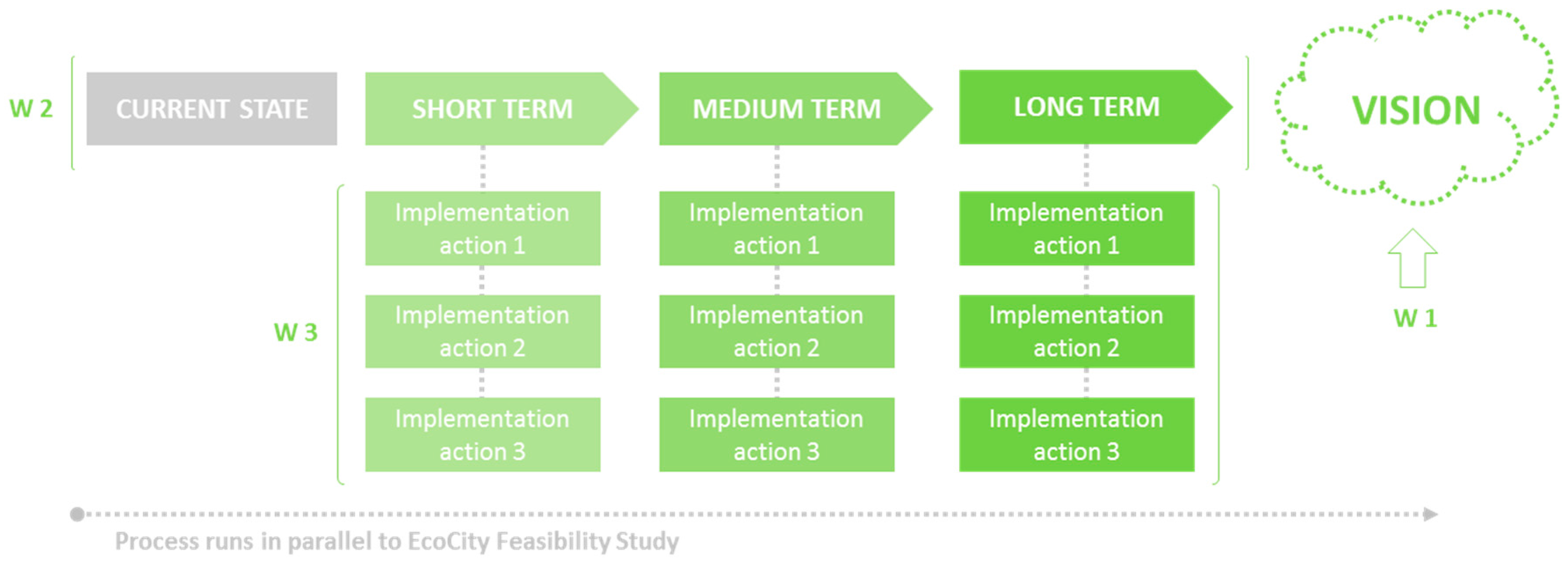
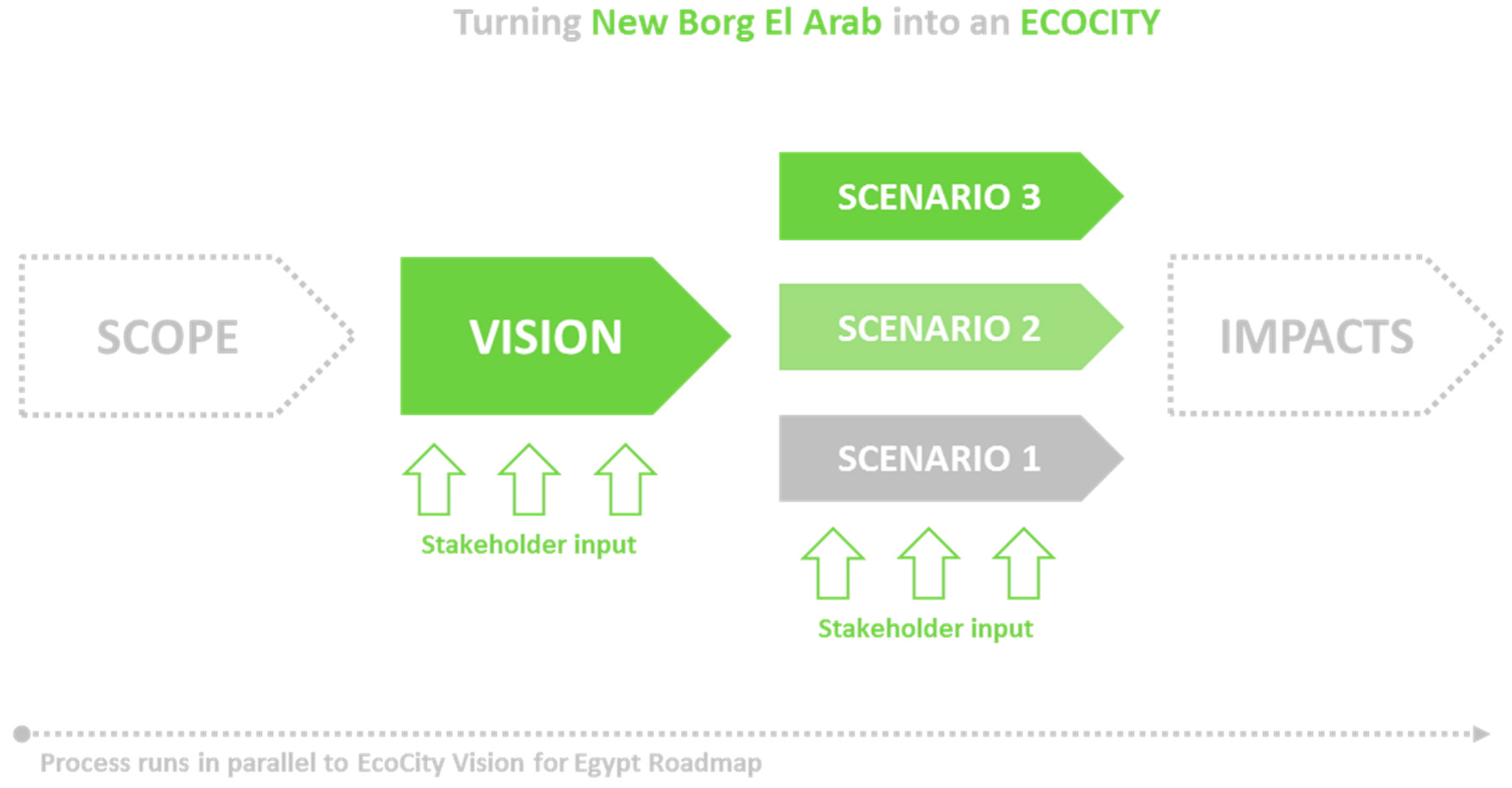
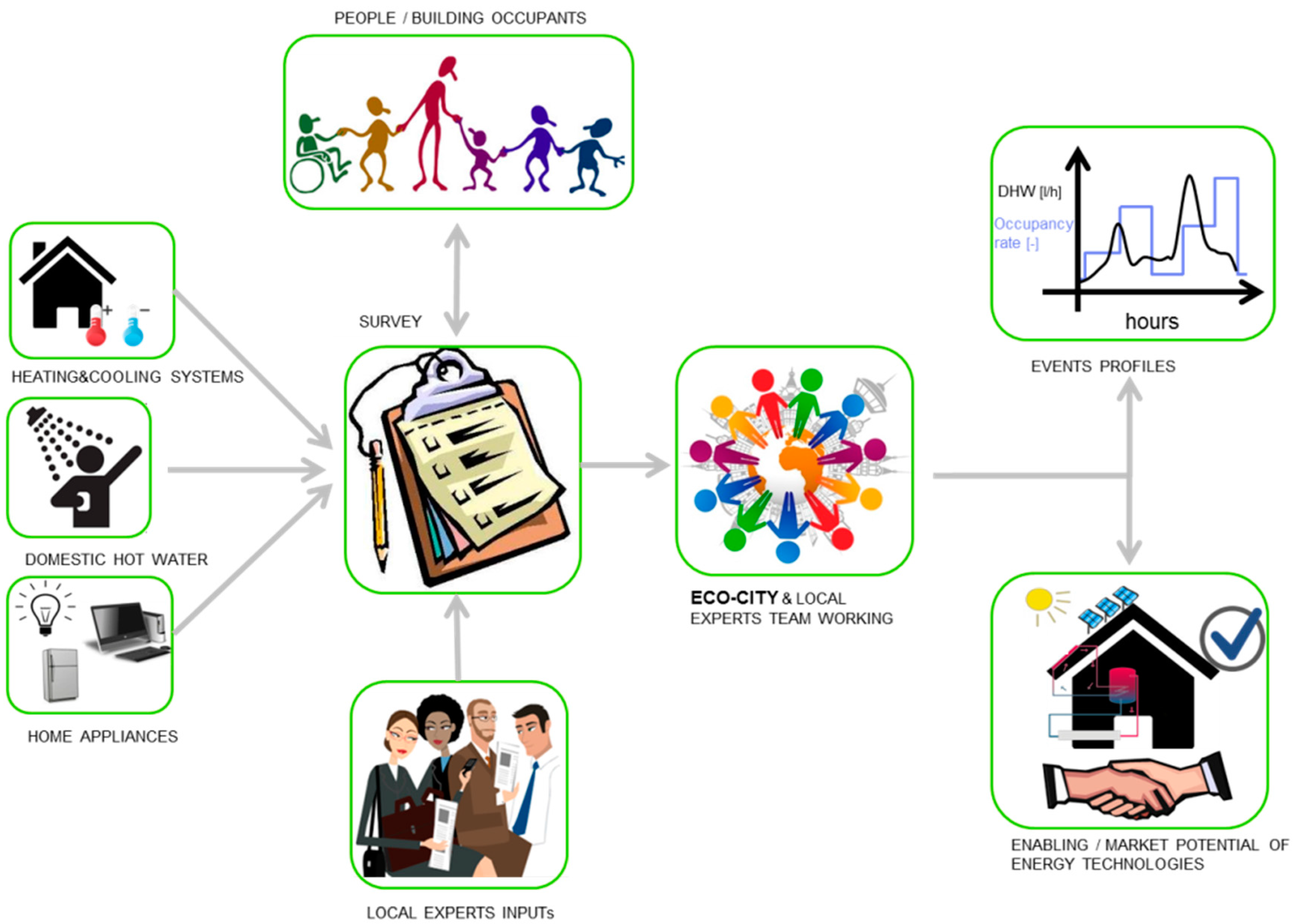
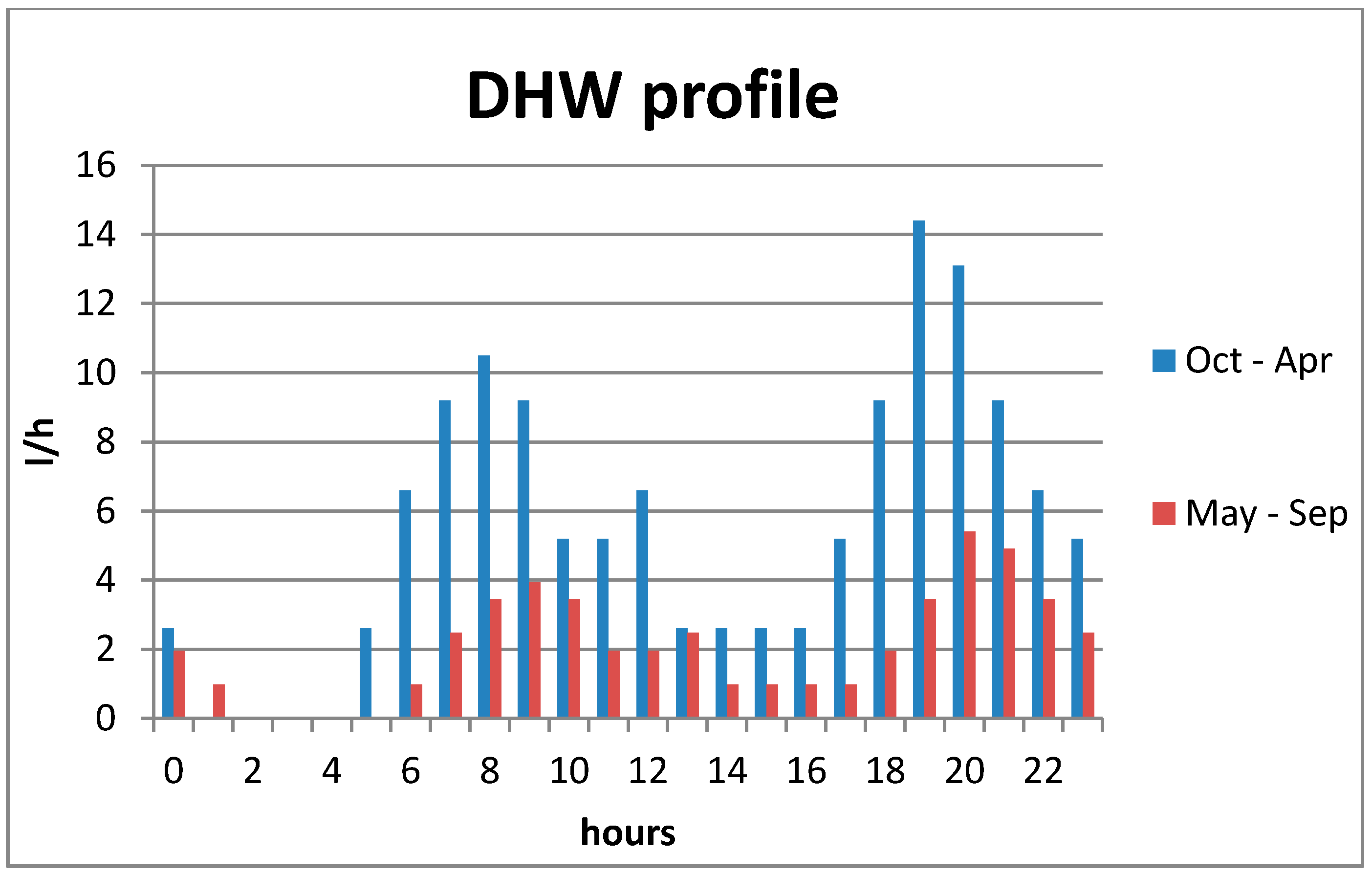
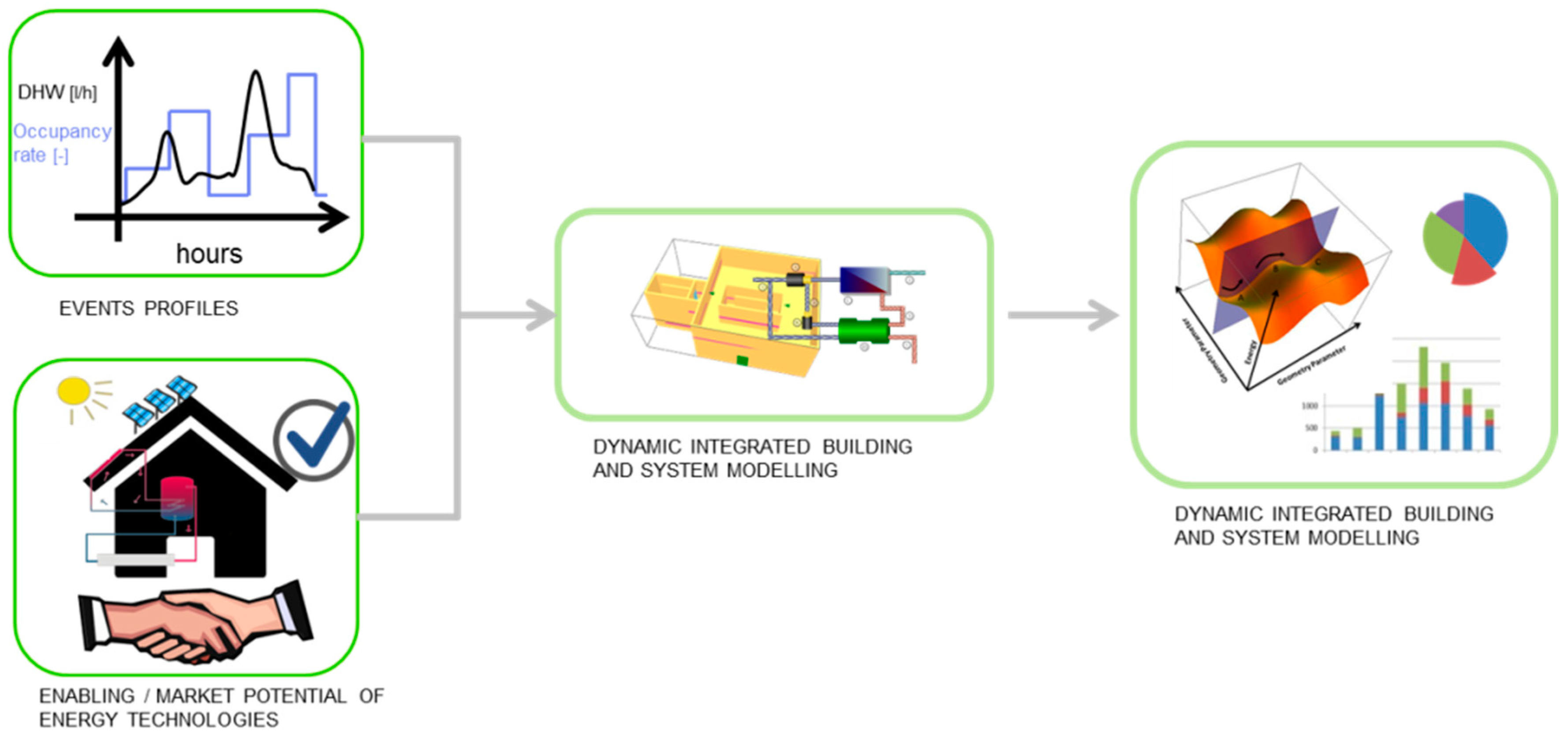

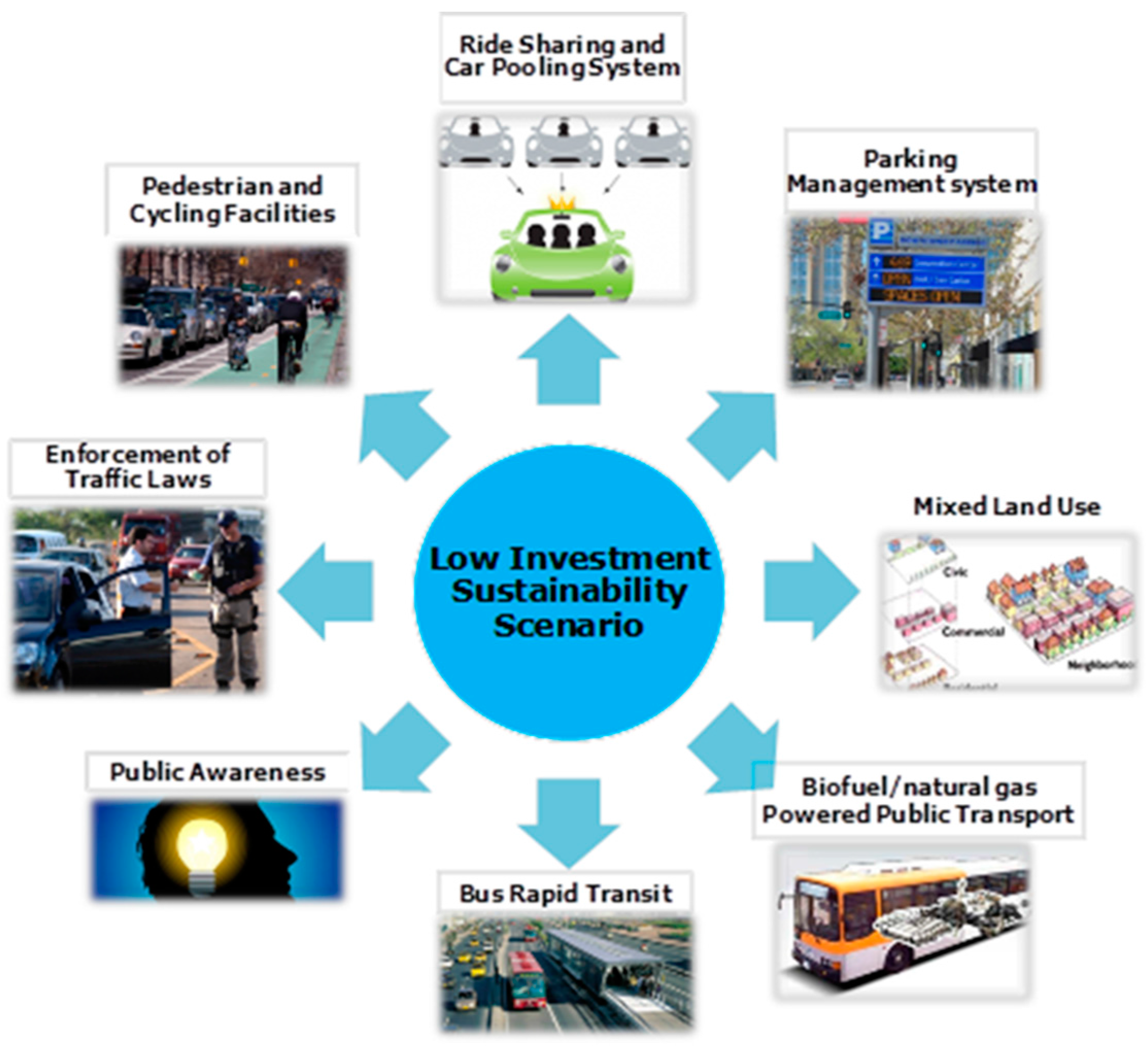
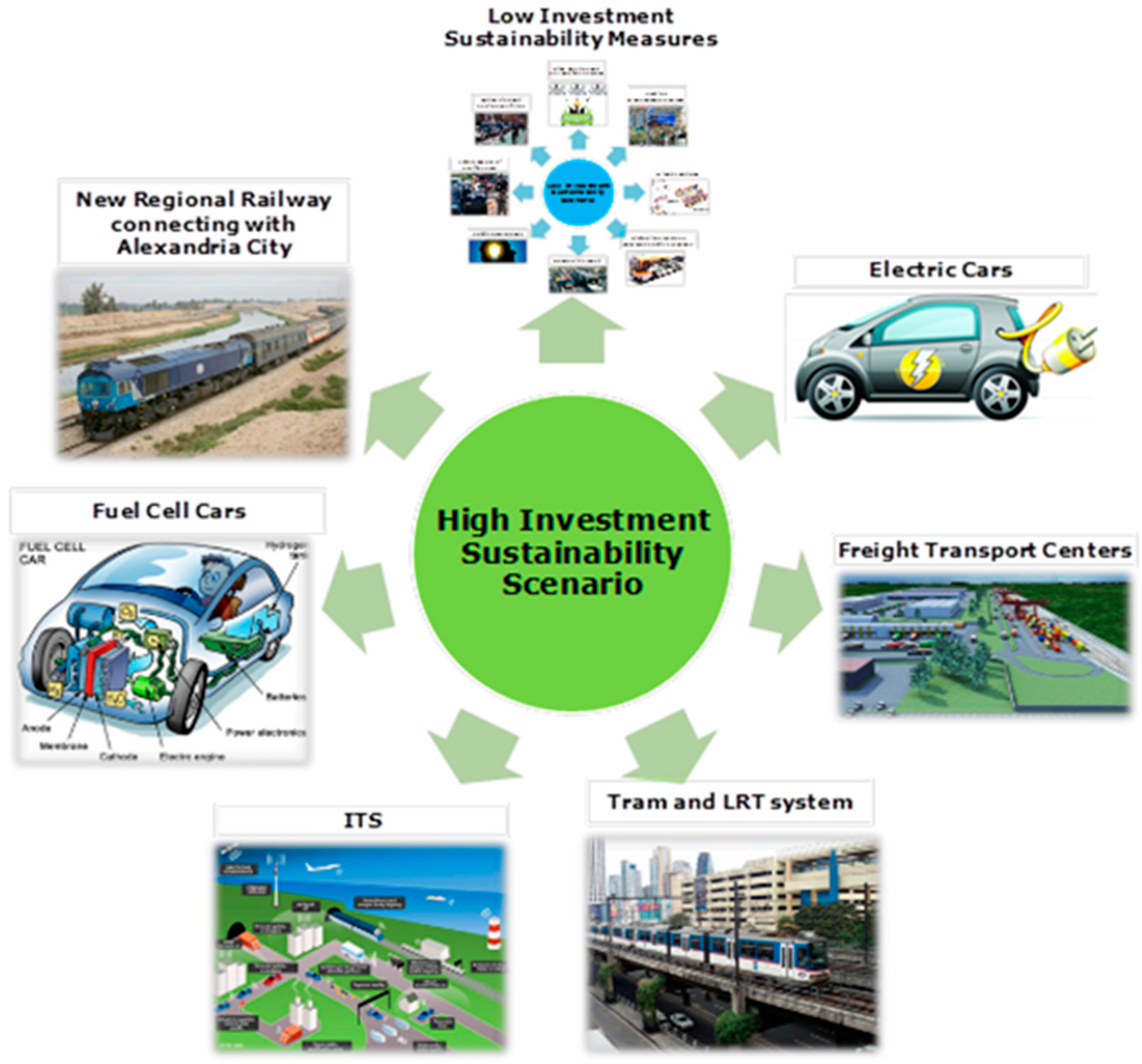
| ENERGY |
| Possibility to sell extra energy to the grid |
| Local building energy code (including lighting) |
| Solar water heating |
| Solar air conditioning |
| Waste to energy |
| Increase public awareness |
| Use of efficient lighting solutions |
| Smart use of energy (reduce peak consumption, energy storage, load matching, smart control) |
| Energy efficiency |
| Use of local materials |
| -------------------------- |
| Targets: |
|
| WATER |
| Water conservation |
| Water quality |
| Non-conventional water resources (solar desalination…) |
| Fresh water management |
| Sufficient water supply |
| Minimization of water consumption |
| Recycling and reuse of treated waste water |
| Provision of fresh drinking water and sanitation |
| Rain harvesting |
| Increase public awareness |
| --------------------- |
| Targets: |
|
| WASTE |
| In situ sorting of waste |
| Increase public awareness |
| Waste minimization |
| ------------------ |
| Targets: |
|
| Water and Waste |
| Water metering and efficient water use campaign |
| Joint water training programme |
| Waste-to-energy development programme |
| Desalination development programme |
| Campaign to reuse and recycle |
| Energy |
| National energy strategy |
| Energy efficiency improvement programme for businesses |
| Solar energy expansion programme |
| Smart grid action plan |
| Solar cooling development programme |
| Transportation and traffic |
| Policy shift to public transport |
| Multi-modal integrated public transport planning initiative |
| Privileges for car-pooling and alternative vehicles |
| Rail traffic development programme |
| Walking and cycling promotion programme |
| Buildings and construction |
| Healthy and safe buildings programme |
| Energy efficiency improvement programme |
| Improved building permit process |
| Quality housing expansion programme |
| Technologies | Business As Usual (BAU) | Low Investment Scenario (LIS) | High Investment Scenario (HIS) |
|---|---|---|---|
| System technologies | Incandescent 20% and fluorescent lamp 80% | Fluorescent light bulbs | LEDs |
| Free cooling system relying on opening windows when rooms are occupied (natural ventilation only) | Free cooling system using vents (natural ventilation only) | Mixed free cooling ventilation system (through vents + mechanical ventilation) | |
| - | Unglazed solar thermal collectors | Glazed solar thermal collectors | |
| - | - | PV | |
| Envelope solutions | - | External reflective paint | External reflective paint |
| Double wall of half red-brick with 5 cm air gap in between | Insulation (5 cm on the ground floor and the Roof, 3 cm on the external walls) | Insulation (6 cm on the ground floor and the Roof, 5 cm on the external walls) | |
| - | Shading system | Shading system | |
| Double glass window | Double glass window | Double glass low-e (low thermal emissivity) window |
| Energy & Emissions | BAU | LIS | HISa | HISb | HISc |
|---|---|---|---|---|---|
| Final district energy demand (GWh) | 619.6 | 315.5 | 219.8 | 219.8 | 219.8 |
| Districts’ produced PV energy (GWh) | - | - | 335.5 | 603.9 | 763.1 |
| Districts’ consumed PV energy (GWh) | - | - | 114.7 | 189.7 | 205.7 |
| Districts’ exported PV energy (GWh) | - | - | 116.6 | 236.2 | 343.5 |
| Final districts energy balance (GWh) | 846.2 | 542.1 | 215.1 | 20.4 | −103.0 |
| CO2 emission (1000 t) | 394.3 | 252.6 | 100.2 | 9.5 | −48.0 |
| Measures | Description | Consultant’s Experience | Worldwide Prices | ||
|---|---|---|---|---|---|
| Cost Unit | Total Cost (Million LE) | Cost Unit | Total Cost (Million LE) | ||
| BRT Rapid Transit Network on the main roads of NBC | BRT systems, with average route length 99 km covering NBC over 98 stations. | 3.2 Million LE Per km | 316.8 | 54 Million LE Per km | 5,346 |
| Pedestrian and Cycling Facilities | Pedestrian facilities include paths, sidewalks, crosswalks, walkways, stairs, ramps, and building entranceways. Cycling facilities, all roads should be considered cycling facilities (except where cycling is specifically prohibited). The cycling network should be a network of streets (a grid of 0.5 kilometers or less in urban areas) that ensure safe bicycle access to all popular destinations. Pedestrian and Cycling Facilities will cover NBC over length equal 200 km. | 25,000 LE Per km | 5.0 | 25,000 LE Per km * | 5.0 |
| Calming Measures in city centers | Traffic calming measures are engineering tools used with the goal of reducing vehicle speed and improving the safety of motorists, pedestrians, and bicyclists. Four types of measures are recommended: Vertical deflections, horizontal shifts, and roadway narrowings are intended to reduce speed and enhance the street environment for non-motorists. Closures (diagonal diverters, half closures, full closures, and median barriers) are intended to reduce cut-through traffic by obstructing traffic movements in one or more directions. | 0.5 | 0.5 * | ||
| Parking Management system in city centers | Introduce a Parking Management system for access controls and customer management (such as for retail, residents and employees) as well as Park & Ride concepts for commuters turn the city into an inviting space. | 1.5 | 1.5 * | ||
| Biofuel/natural gas powered public transport | |||||
| Maintenance of vehicles to the manufacturer's specifications and applying for Vehicle Scrapping Programme | |||||
| Scenario Cost (Million LE) | 323.8 | 5,353.0 | |||
| Measures | Description | Consultants Experience | Worldwide Prices | ||
|---|---|---|---|---|---|
| Cost Unit | Total Cost (Million LE) | Cost Unit | Total Cost (Million LE) | ||
| Bus Rapid Transit Network on the main roads of NBC | BRT systems, with average route length 55 km covering NBC over 55 station. | 3.2 Million LE Per km | 176 | 54 Million LE Per km | 2,970 |
| Light Rail Transit Network on the main roads of NBC | Light Rail Transit, with average route length 102 km covering NBC over 83 station. | 7.5 Million LE Per km | 765 | 161.25 Million LE Per km | 16,447.5 |
| New Regional Railway connecting with Alexandria City | New Regional Railway with average route length 60 km. | 11.0 Million LE Per km | 660 | 11.0 Million LE Per km * | 660 * |
| Implement Intelligent Traffic System | The intelligent traffic system is implemented using road side units (RSU) with friction monitoring, vehicles with environmental sensors and a database for data transfer through different platforms. | ||||
| Implement freight transport centers | Implement three Freight transport centers include classification yards and truck terminals where passengers and cargo are exchanged between vehicles or between transport modes. | 50.0 Million LE Per Center | 150 | 50.0 Million LE Per Center * | 150 * |
| Pedestrian and Cycling Facilities | Pedestrian facilities include paths, sidewalks, crosswalks, walkways, stairs, ramps, and building entranceways. Cycling facilities, all roads should be considered cycling facilities (except where cycling is specifically prohibited). The cycling network should be a network of streets (a grid of 0.5 kilometers or less in urban areas) that ensure safe bicycle access to all popular destinations. Pedestrian and Cycling Facilities will cover NBC over length equal 200 km. | 25,000 LE Per km | 5 | 25,000 LE Per km * | 5 * |
| Calming Measures in city centers | Traffic calming measures are engineering tools used with the goal of reducing vehicle speed and improving the safety of motorists, pedestrians, and bicyclists. Four types of measures are recommended: Vertical deflections, horizontal shifts, and roadway narrowings are intended to reduce speed and enhance the street environment for non-motorists. Closures (diagonal diverters, half closures, full closures, and median barriers) are intended to reduce cut-through traffic by obstructing traffic movements in one or more directions. | 0.5 | 0.5 * | ||
| Parking Management system in city centers | Introduce a Parking Management system for access controls and customer management (such as for retail, residents and employees) as well as Park & Ride concepts for commuters turn the city into an inviting space. | 1.5 | 1.5 * | ||
| Biofuel/natural gas powered public transport | |||||
| Maintenance of vehicles to the manufacturer’s specifications and applying for Vehicle Scrapping Programme | |||||
| Scenario Cost (Million LE) | 1,758.0 | 20,234.5 | |||
© 2016 by the authors; licensee MDPI, Basel, Switzerland. This article is an open access article distributed under the terms and conditions of the Creative Commons Attribution (CC-BY) license (http://creativecommons.org/licenses/by/4.0/).
Share and Cite
Antuña-Rozado, C.; García-Navarro, J.; Reda, F.; Tuominen, P. Methodologies Developed for EcoCity Related Projects: New Borg El Arab, an Egyptian Case Study. Energies 2016, 9, 631. https://doi.org/10.3390/en9080631
Antuña-Rozado C, García-Navarro J, Reda F, Tuominen P. Methodologies Developed for EcoCity Related Projects: New Borg El Arab, an Egyptian Case Study. Energies. 2016; 9(8):631. https://doi.org/10.3390/en9080631
Chicago/Turabian StyleAntuña-Rozado, Carmen, Justo García-Navarro, Francesco Reda, and Pekka Tuominen. 2016. "Methodologies Developed for EcoCity Related Projects: New Borg El Arab, an Egyptian Case Study" Energies 9, no. 8: 631. https://doi.org/10.3390/en9080631
APA StyleAntuña-Rozado, C., García-Navarro, J., Reda, F., & Tuominen, P. (2016). Methodologies Developed for EcoCity Related Projects: New Borg El Arab, an Egyptian Case Study. Energies, 9(8), 631. https://doi.org/10.3390/en9080631







